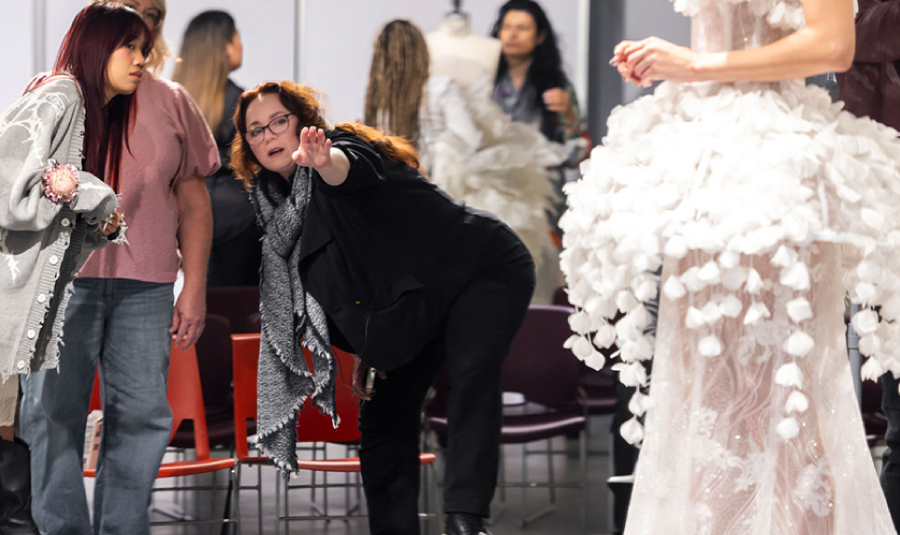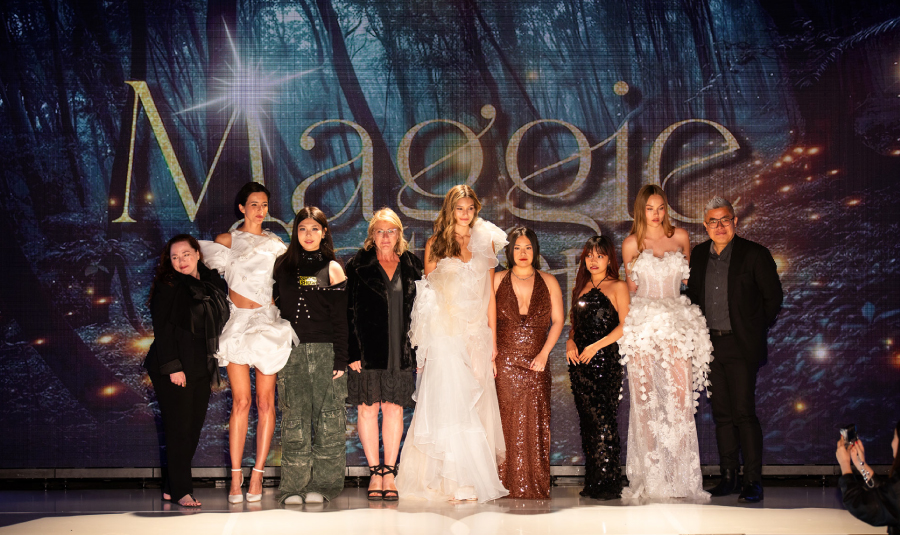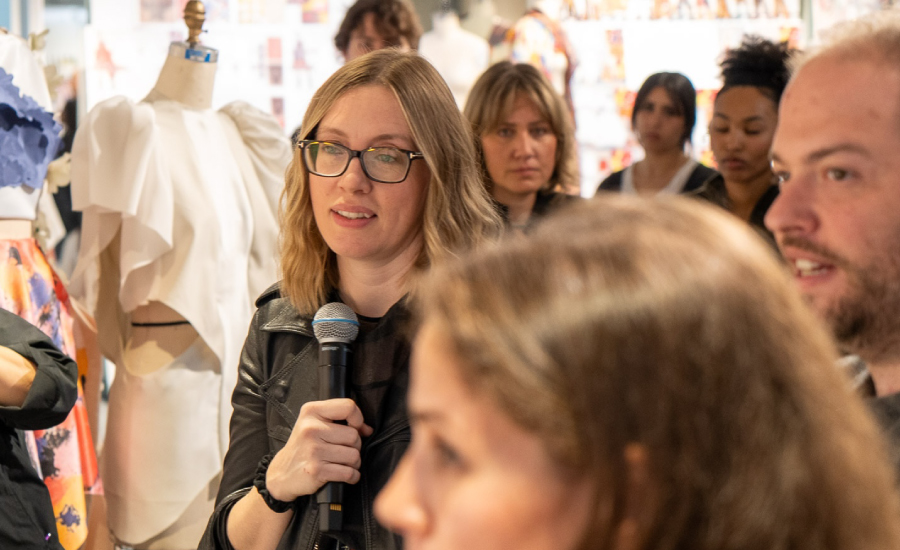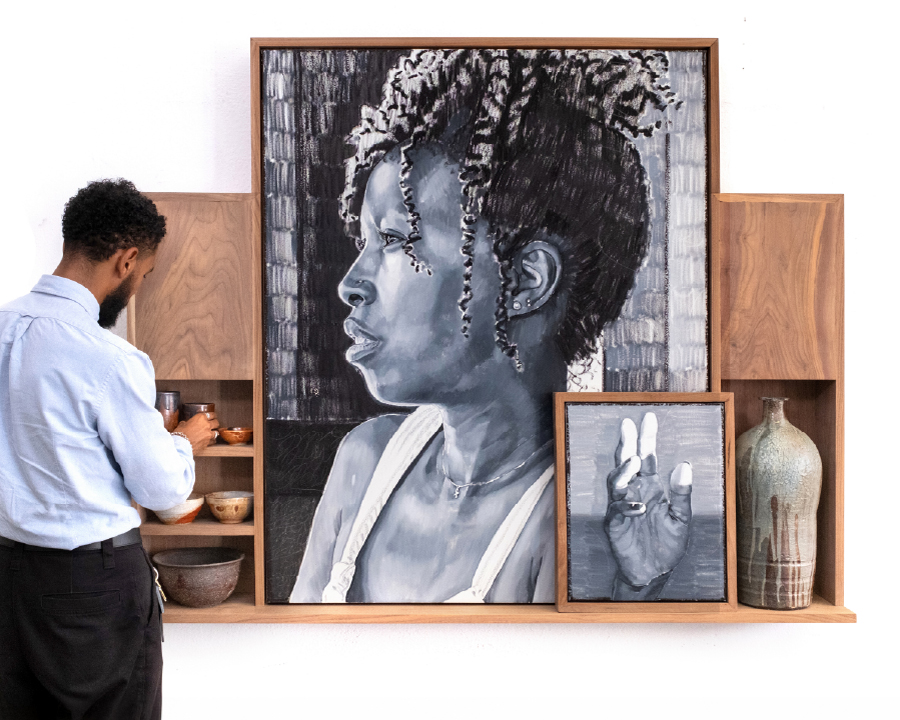Otis College Alum Mentors Fashion Design Students on Sustainable Bridal Project
Patricia DeLaunay (’04 BFA Fashion Design) and bridal brand Maggie Sottero are shifting the tide towards a more sustainable industry.

Since the Victorian era, luck-seeking brides have worn “something old and something new” on their wedding day in the hopes it would lead to a long and happy union. The stunning results of one of the latest mentorship projects at Otis College of Art and Design’s Fashion Design program make the two synonymous.
Juniors and seniors worked with the leadership team of bridal brand Maggie Sottero to upcycle deadstock gowns into original creations for brides-to-be. The project came to fruition thanks to Patricia DeLaunay (’04 BFA Fashion Design), Global Sustainability Director and Designer for Maggie Sottero.
As a dedicated animal lover, DeLaunay had been thinking about the fashion industry’s impact on wildlife and the planet since the mid-1990s, when the use of fur opened her eyes to fashion’s harmful practices. She found support in Otis’s Fashion Design program. “[Sustainability] was talked about and mentioned in classes,” DeLaunay says. She was encouraged to do an independent study on the topic and populate her portfolio with a sustainable collection, an experience that helped her discern a path forward.
Where was I going to go if I wanted to be an environmentalist, but also a designer? How do you balance those two passions?"
DeLaunay, who also runs a small eponymous women’s wear line, was way ahead of the curve when she was at Otis, but this challenge is top of mind for many current students. Otis’s in-demand Sustainability minor is especially popular among Fashion Design students.
It’s why this mentorship project resonated with so many students, while also aligning with Maggie Sottero’s environmental goals. In a market typically focused on wear-once gowns, the brand is shifting the tide with initiatives like planting a tree for every gown sold, investing in the circular supply chain, and working toward zero waste.
“The sustainability aspect of this project was really important for us, and that we were going to be able to donate so many gowns and see what [the students] could do with upcycling—kind of like a laboratory,” DeLaunay says. “But it was also about connecting directly with some of our Gen Z cohort. They’re not just going to be our next designers. Some of them are going to be our next brides.”

Wedding Dress Alchemy
Students were tasked with reimagining stock Maggie Sottero gowns into bridal creations inspired by nature. “One of the big challenges was that we really wanted them to use as much of the fabric from the original dresses as they could to minimize waste,” DeLaunay says. “And if they were going to do embellishments, we wanted to make sure most came from the source materials.”
The creativity these parameters inspired was on full display during a fitting session in March, as models walked down a stage on the third floor of the Anna Cole building on Otis’s Los Angeles campus. The space was crowded with students as DeLaunay, along with Maggie Sottero CEO and Creative Director Kelly Midgley and Lead Designer Edric Woo, offered students feedback and direction.
The skirt of a cocktail dress with a plunging neckline was tacked up to expose more crinoline. Fashion Design chair Jill Zeleznik helped a student reverse a delicate floral vest to highlight its artistry. “Just turn everything around! That’s a top-secret design trick,” Midgley offered with a laugh. An elegant cascade of laser-cut ginkgo leaves fluttered on a sweetheart dress, eliciting aahs. In a feat of true technical dexterity, one student presented a bridal suit with billowing trousers and a perfectly fitted bustier made from the material of a gown cut almost entirely on the bias. “It’s so stylish,” said Midgley. DeLaunay leaned in appreciatively: “To think what it was and what it is now,” she marveled.

Later, she remarks on the students’ thoughtfulness and commitment. “I had high expectations because I know how rigorous the Otis Fashion Design program is. Even with my high expectations, I was blown away,” DeLaunay says. “I’m especially grateful for the way they threw themselves into the sustainability aspect of the direction because it was not easy. But they stayed dedicated. It was incredible.”
I had high expectations because I know how rigorous the Otis Fashion Design program is. Even with my high expectations, I was blown away."
The passion of the next generation of designers, coupled with the progress being made in the fashion world and the cascade effect she hopes making Maggie Sottero a regenerative brand will have in the bridal industry, fuels DeLaunay’s optimism. “When I graduated in 2004, if I wanted to be a sustainability-focused designer the job prospects were slim pickings,” she says. “And now look at us. The graduates this year from Otis could very well be applying [for jobs] at Maggie Sottero, a fashion brand that has a sustainability director and where we are implementing sustainable design. There’s every reason to hope.”
Watch Maggie Sottero’s video, “The Power of Mentorship,” about its project with Otis College of Art and Design.



